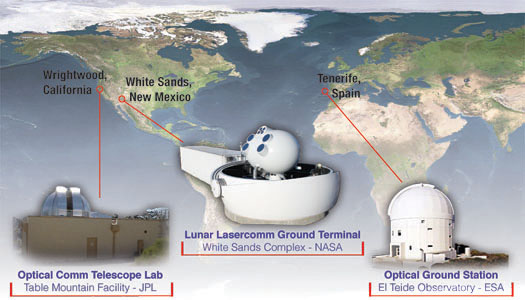Optical Communications Ground Receivers
Lunar Lasercom Ground Terminal
The Lunar Lasercom Ground Terminal (LLGT) is the primary ground receiver for the Lunar Lasercomm Space Terminal (LLST) transmissions. It it located in White Sands, NM, and is managed by NASA Goddard Spaceflight Center and MIT Lincoln Lab.
System Overview
The LLGT is the primary ground station for the LLCD. It has four uplink transceivers and four downlink receivers. The transceivers and hooked up to a 10 W uplink beam. Paired with a fast-steering mirror, the downlink is tracked with a 25 Hz feedback loop. Downlink receivers are commercially-available 40 cm telescopes with added tracking systems, optics, and a multi-mode fiber for coupling the downlink beam. Downlink to the LLGT is up to ~622 Mbps and uplink is up to ~19 Mbps.
Operation
A link was established with the LLGT on 55 passes averaging 16 minutes and up to 29 minutes long. Link acquisition is acquired in a multi-step process. First, a wide 45 μrad diameter beam is pointed at the known position of the LLST. Once a signal has been detected, the LLST points a downlink beam towards the LLGT and the the uplink comm wavelength is coupled to the LLST receiver fiber to establish uplink data transfer. The transmitting telescopes can uplink at 20 Mbps.
Lunar Lasercom OCTL Terminal
The Lunar Lasercom OCTL Terminal (LLOT) is an auxiliary receive-only ground station for the LLCD. It is located in Wrightwood, CA, and is operated by JPL. Downlink to the LLOT is up to 39 Mbps. A link is established in a similar way to the LLGT, but is ultimately receive-only. The laser beacon pointed at the LLST is made by 6 separate lasers spaced ~310 mm apart to achieve a hexagonal beam.
Link Acquisition Process
A 1558 nm laser beacon is projected at the expected location of the LLST. To have a sufficient power density while still scanning through the uncertainty ellipse of the satellite location (a computed 191 μrad angular uncertainty), a ‘step-stare’ system is used. The beacon points at a given point in the uncertainty ellipse for 5 seconds, enough time that a link would be detected, and cycles to the next point if nothing is received, using a wide 110 μrad angular diameter beam. This method scans for roughly 100 seconds, cycling through the 19 steps. With an acquisition and tracking detector, the beacon is received and the 1550 nm downlink laser is returned. Since there is no uplink data transmission, a free-running LLST clock is used without locking. Once the downlink laser is received, at roughly 3.6 nW/m2, the beacon beam is narrowed to 40 μrad and the LLST control loop is adjusted to receive the beacon with higher precision, now boosted to 36 nW/m2. This concludes the link acquisition process, with roughly 90% of downlink signal power being directed at the receiver.
LLST Downlink Margins
| Minimum irradiation above atmosphere: | 1.66 | nW/m2 |
| Minimum signal power: | -215 | dB-W |
| Signal power on detector: | -98.2 | dB-W |
| Mean background photon flux: | 5.18 | Mph/s |
| Mean photon flux: | 140 | Mph/s |
| Link margin: | -3 | dB |
Use for OPALS
For the OPALS demonstration, a pointing file used to actuate the optical telescope for tracking the ISS was generated from location data less than an hour from the start of the pass. The low orbit and big cross-section of the ISS results in significant drag and low accuracy from ephemeris predictions, which are generally inadequate after a few orbits.
Lunar Lasercom Optical Ground System
The Lunar Lasercom Optical Ground System (OGS) is another auxiliary ground station for the LLST, located on Tenerife and operated by ESA. The minimum downlink irradiance at the border of the atmosphere is specified at 0.17 nW/m2. It does things.
